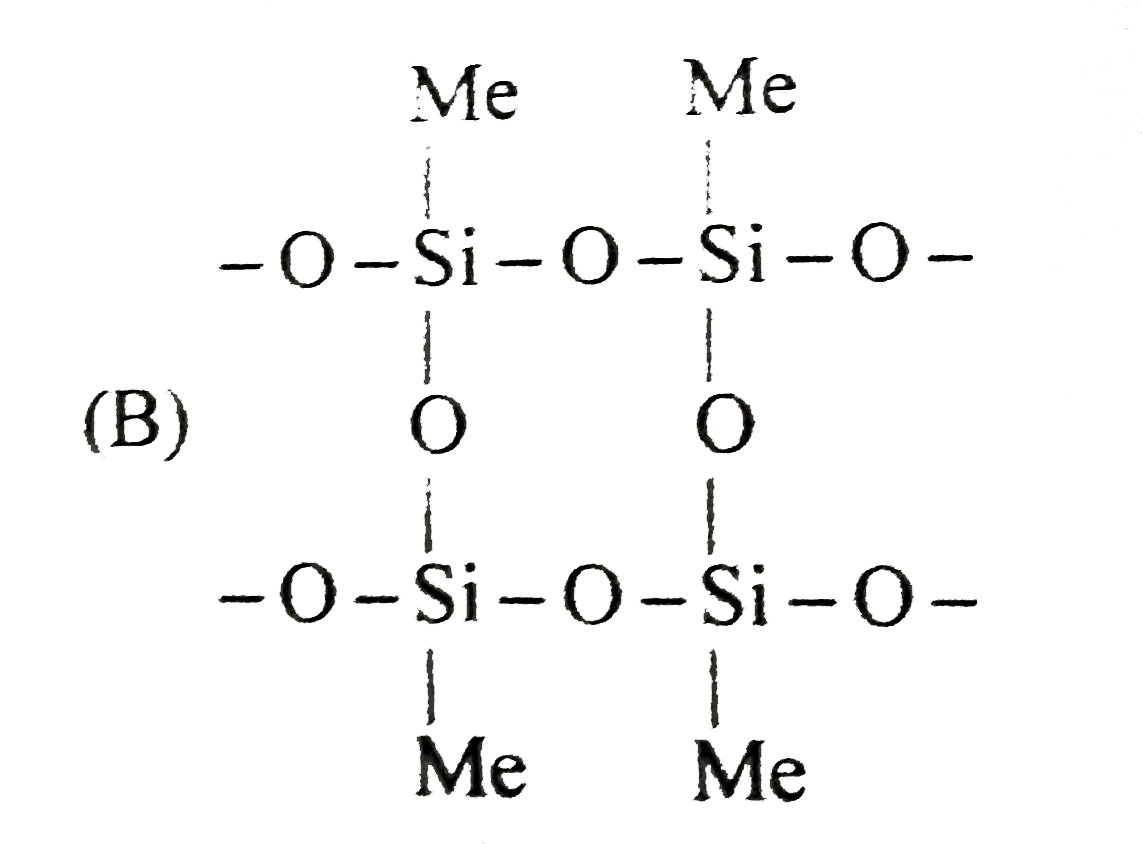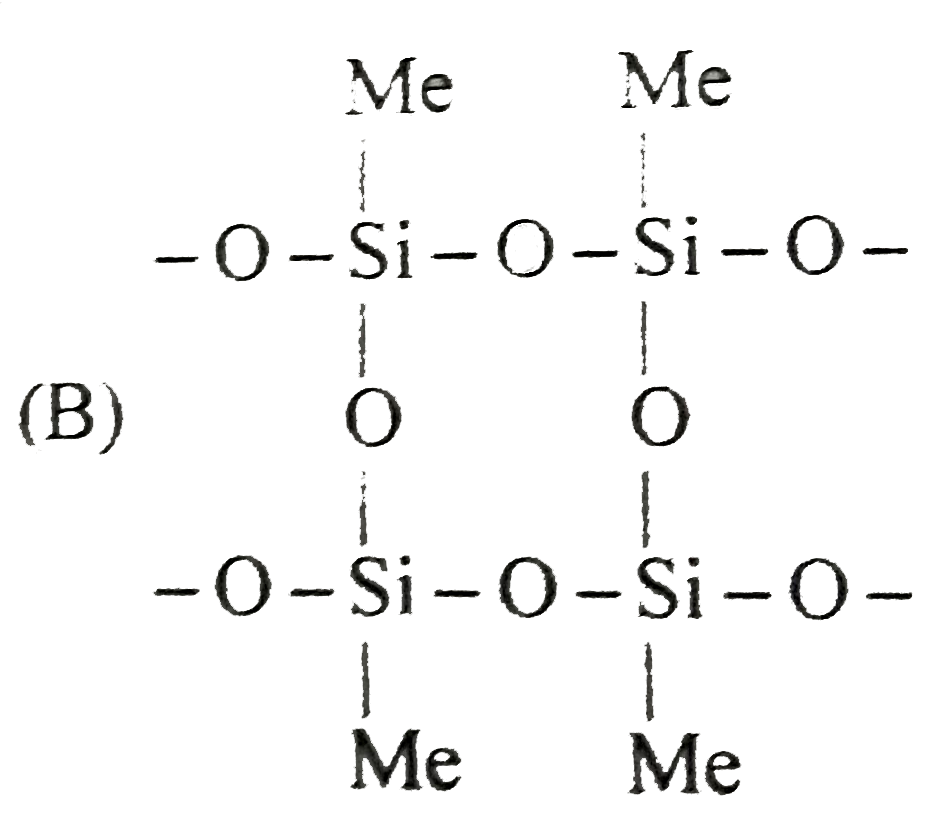When octa methyl cellobiose is hydrolyzed by aqueous acid, two methylated glucose derivative are formed. One is a tetramethyl derivative, and the other is a trimethyl derivative. Whyd is a single methyl substituent lost in this process ?
one methyoxy group is lost by elimination
one methyoxy group is an ester and the other are all ethers.
one methyoxy group is part of an acetal, the others are all ethers..
one glucose is an methyl glycoside, the other is a methyl glycoside
The correct Answer is:3
Acetals are hydrolysed in aqueous acids, whereas ethers are not.

Topper's Solved these Questions
Similar Questions
Read the following write-ups and answer the question at the end of it.
Silicones are synthetic polymers containing repeated R2SiO units. Since, the empirical formula is that of a ketone (R2CO) , the name silicone has been given to these materials. Silicones can be made into oils, rubbery elastomers and resins. They find a variety of applications because of their chemical inertness, water repelling nature, heat-resistance and good electrical insulating property. Commerical silicon polymers are usually methyl derivatives and to a lesser extent phenyl derivatives and are synthesised by the hydrolysis of
R2SiCl2[R=methyl (Me) or phenyl(ϕ)]
Me2SiCl2H2O−−→O−Me∣Si∣Me−O−Me∣Si∣Me−O−Me∣Si∣Me−O
If we start with MeSiCl3 as the starting material, silicones formed is :View SolutionRead the following write-ups and answer the question at the end of it.
Silicones are synthetic polymers containing repeated R2SiO units. Since, the empirical formula is that of a ketone (R2CO) , the name silicone has been given to these materials. Silicones can be made into oils, rubbery elastomers and resins. They find a variety of applications because of their chemical inertness, water repelling nature, heat-resistance and good electrical insulating property. Commerical silicon polymers are usually methyl derivatives and to a lesser extent phenyl derivatives and are synthesised by the hydrolysis of
R2SiCl2[R=methyl (Me) or phenyl(ϕ)]
Me2SiCl2H2O−−→O−Me∣Si∣Me−O−Me∣Si∣Me−O−Me∣Si∣Me−O
If we mix Me3SiCl with Me2SiCl2, we get silicones of the type:View Solution
Knowledge Check
- Question 1 - Select One
Read the following write-ups and answer the questions at the end of it.
Silicons are synthetic polymers containing repeated R2SiO unit. Since, the imperical formula of a ketone (R2CO), the name silicone has been given to this materials. silicons can be made into oils, rubberly elastamors and resins. They find a variety of applications because of their chemical inertness,water repelling nature, heat-resistence and good electrical insulating property.
Commercial silicone polymers are usally methyl derivatives and to lesser a extent phenyl derivatives and are synthesised by the hydrolysis of
R2SiCl2 [R =methyl (Me) or phenyl (ϕ)]
Me2SiCl2H2O−−→O−Me∣Si∣Me−O−Me∣Si∣Me−O−Me∣Si∣Me−O−
If we start with MeSiCl3 as the starting material, silicons formed is :AMe−Me∣Si∣Me−O−Me∣Si∣Me−O−Me∣Si∣Me−O−Me∣Si∣Me−MeB CNoth of the aboveDNone of the above
CNoth of the aboveDNone of the above - Question 2 - Select One
Read the following write-ups and answer the questions at the end of it.
Silicons are synthetic polymers containing repeated R2SiO unit. Since, the imperical formula of a ketone (R2CO), the name silicone has been given to this materials. silicons can be made into oils, rubberly elastamors and resins. They find a variety of applications because of their chemical inertness,water repelling nature, heat-resistence and good electrical insulating property.
Commercial silicone polymers are usally methyl derivatives and to lesser a extent phenyl derivatives and are synthesised by the hydrolysis of
R2SiCl2 [R =methyl (Me) or phenyl (ϕ)]
Me2SiCl2H2O−−→O−Me∣Si∣Me−O−Me∣Si∣Me−O−Me∣Si∣Me−O−
If we mixMe3SiCl with Me2SiCl2, we get silicones of the typeAMe−Me∣Si∣Me−O−Me∣Si∣Me−O−Me∣Si∣Me−O−Me∣Si∣Me−MeB Cboth of the aboveDnone of the above
Cboth of the aboveDnone of the above - Question 3 - Select One
Unknown compound A C9H8O5 on methylation with (CH3)SO4/NaOH forms methyl derivative whose MW is 210. The number of hydroxyl groups is A is
AfiveBfourConeDthree
In presence of excess base and exces shalogen a methyl ketone is converted first into a trihalo substituted ketone and then into a carbonylc acid . After the trihalo substituted ketone is formed hydroxide ion attacks the carboxyl carbon because the trihalo methyl ion is the group more easily expelled from the tetrahedral intermediate .The conversion of methyl ketone to a carboxylic acid is called a haloform reaction because one of the product is halofor (CHCl3) or CHI3 or CHBr3.

Which of the following compoud show haloform reaction and racemisation in OD−/D2O.View SolutionIn the presence of excess base and excess halogen a methylketone is converted first into a trihalo substituted ketone and then into a carboxylic acid.After the trihalo substituted ketone is formed hydroxide ion attacks the carboxyl carbon because the trihalo methyl ion is the group more easily expelled from the tetrahedral intermediate.The conversion of a methyl ketone to a carboxylic acid is called a haloform reaction because one of the product is haloform (CHCl3) or CHI3 or CHBr3.

Which of the following compound show haloform reaction and racemisation in OD−/D2OView SolutionIn the presence of excess base and excess halogen a methylketone is converted first into a trihalo substituted ketone and then into a carboxylic acid.After the trihalo substituted ketone is formed hydroxide ion attacks the carboxyl carbon because the trihalo methyl ion is the group more easily expelled from the tetrahedral intermediate.The conversion of a methyl ketone to a carboxylic acid is called a haloform reaction because one of the product is haloform (CHCl3) or CHI3 or CHBr3.

Ph−C∣∣O−Et∣C∣Me−C∣∣O−CH3(1)I2/OH⊕−−−−−−−→(2)H⊕(3)Δ Product isView SolutionWhen an aqueous solution of a colourless mixture of two salts is treated with a drop of chlorine water, the solution becomes brown. Some chloroform is added to the brown solution and the resulting mixture is shaken wel. The chloroform layer becomes violet.
(ii) When chlorine water is again added dropwise to the above mixture, the chloroform layer becomes colourless.
(iii) On being heated with solid K2Cr2O7 and concentrated H2SO4, the solid mixture gives vapours of a dark colour which form a yellow solution with aqueous NaOH. On acidification with acetic acid followed by treatment with lead acetate, the yellow solution gives a yellow precipitate.
(iv) When boiled with an NaOH solution, the mixture gives a gas that produces thick white fumes with HCl vapours and turns nessler's reagent brown. the mixture does not respond to any other test for cations.
(v) The mixture, on being heated, gets completely sublimed.
Q. What is the oxidation sate of the central atom in the anion constituting the yellow precipitate obtained in (iii)?View SolutionWhen an aqueous solution of a colourless mixture of two salts is treated with a drop of chlorine water, the solution becomes brown. Some chloroform is added to the brown solution and the resulting mixture is shaken wel. The chloroform layer becomes violet.
(ii) When chlorine water is again added dropwise to the above mixture, the chloroform layer becomes colourless.
(iii) On being heated with solid K2Cr2O7 and concentrated H2SO4, the solid mixture gives vapours of a dark colour which form a yellow solution with aqueous NaOH. On acidification with acetic acid followed by treatment with lead acetate, the yellow solution gives a yellow precipitate.
(iv) When boiled with an NaOH solution, the mixture gives a gas that produces thick white fumes with HCl vapours and turns nessler's reagent brown. the mixture does not respond to any other test for cations.
(v) The mixture, on being heated, gets completely sublimed.
Q. The brown solutin obtained in (i) is due to:View Solution

